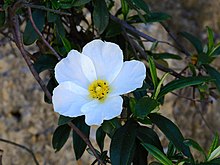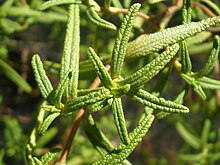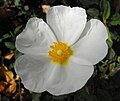Cistus (original) (raw)
From Wikipedia, the free encyclopedia
(Redirected from Halimium)
Genus of flowering plants in the rock rose family Cistaceae
| Cistus | |
|---|---|
 |
|
| Cistus monspeliensis | |
| Scientific classification |
|
| Kingdom: | Plantae |
| Clade: | Tracheophytes |
| Clade: | Angiosperms |
| Clade: | Eudicots |
| Clade: | Rosids |
| Order: | Malvales |
| Family: | Cistaceae |
| Genus: | CistusL. (1753) |
| Species[1] | |
| 34; see text | |
| Synonyms[1] | |
| Halimiocistus Janch. (1925) Halimium (Dunal) Spach (1836) Ladanium Spach (1836) Ladanum Raf. (1838), nom. illeg. Ledonia Spach (1836) Libanotis Raf. (1838), nom. illeg. Rhodocistus Spach (1836) Stegitris Raf. (1838) Stephanocarpus Spach (1836) Strobon Raf. (1838) |
Cistus (from the Greek kistos) is a genus of flowering plants in the rockrose family Cistaceae, containing about 20 species (Ellul et al. 2002). They are perennial shrubs found on dry or rocky soils throughout the Mediterranean region, from Morocco and Portugal through to the Middle East, and also on the Canary Islands.
Cistus, with its many hybrids and cultivars, is commonly encountered as a garden flower.
The common name rockrose (rock rose in the UK) is applied to the species, a name also shared by the related genera Helianthemum and Tuberaria, all in the family Cistaceae. The common name gum cistus is applied to resin-bearing species, especially C. ladanifer.
Evergreen leaves of a Cistus species (Cistus monspeliensis)
The leaves are evergreen, opposite, simple, usually slightly rough-surfaced, 2–8 cm long. In a few species (notably C. ladanifer), the leaves are coated with a highly aromatic resin called labdanum.
They have showy 5-petaled flowers ranging from white to purple and dark pink, in a few species with a conspicuous dark red spot at the base of each petal.
Cistus and Halimium form a cohesive and the most derived clade within Cistaceae.[2] Plants of the World Online and World Flora Online treat Halimium as a synonym of Cistus.[3][4] Molecular phylogenetic analyses conducted between 2005 and 2011 confirm that Cistus species divide into two well-defined clades, neither of which was fully resolved internally. The first clade consists of those with purple and pink flowers (the "purple pink clade" or PPC). The second clade consists of those with white flowers or, in the case of Cistus parviflorus, pale pink flowers (the "white or whitish pink clade" or WWPC).[2][5][6][7] Although the flower colour of C. parviflorus is anomalous, it has very short styles, otherwise characteristic of WWPC species. A hybrid origin has been suggested.[5] A simplified cladogram is shown below:[8]
| Species-level cladogram of Cistus species. |
|---|
| Purple Pink Clade White Whitish Pink Clade |
| Species-level cladogram of Cistus species, based on plastid and nuclear DNA sequences.[5][2][6][7] |
Within the purple pink clade (PPC), C. crispus is consistently the first diverging species. C. albidus, C. creticus and C. heterophyllus form a well supported clade. Seven species endemic to the Canary Islands form a polytomy, resolved differently in different analyses, in which subtaxa of some species do not always cluster together. Within the white and whitish pink clade (WWPC), there is weak support for a clade consisting of C. clusii and C. munbyi; the other species either formed part of a polytomy or resolved differently in different analyses. Halimium and Cistus were regularly shown to be paraphyletic with respect to one another.[7]
The following species are recognised in the genus Cistus:[1][7]
Cistus asper Demoly & R.Mesa
Cistus atlanticus (Humbert & Maire) Demoly
Cistus chinamadensis Bañares & P.Romero
Cistus clusii Dunal
Cistus formosus Curtis
Cistus grancanariae Marrero Rodr., R.S.Almeida & C.Ríos
Cistus heterophyllus Desf.
Cistus horrens Demoly
Cistus inflatus Pourr. ex J.-P.Demoly, syn. Cistus psilosepalus Sweet[7]
Cistus ladanifer L., including Cistus palhinhae N.D.Ingram – Gum Rockrose
Cistus lasianthus Lam.
Cistus lasiocalycinus (Boiss. & Reut.) Byng & Christenh.
Cistus macrocalycinus (Pau) Byng & Christenh.
Cistus monspeliensis L. – Montpellier Cistus
Cistus munbyi Pomel
Cistus ocreatus C.Sm.[7]
Cistus ocymoides Lam.
Cistus palhinhae N.D.Ingram
Cistus palmensis Bañares & Demoly
Cistus parviflorus Lam.
Cistus pouzolzii Delile ex Gren. & Godr.
Cistus salviifolius L. – Salvia Cistus
Cistus sintenisii Litard. (syn. C. albanicus)
Cistus tauricus C.Presl
Various species of Cistus

Cistus albidus photo taken near Sitges
Cistus creticus from Crete
Cistus heterophyllus subsp. carthaginensis. Critically endangered cistus from Cartagena (Spain).
Cistus libanotis Photo taken near Cádiz.
Cistus parviflorus from Crete
In addition a large number of hybrids have been recorded, including:[1][9]
- Cistus × aguilari O.E.Warb. (C. ladanifer × C. populifolius[10])
- Cistus × akamantis Demoly
- Cistus × banaresii Demoly
- Cistus × candidus (Sweet) Demoly
- Cistus × canescens Sweet
- Cistus × cebennensis Aubin & J.Prudhomme
- Cistus × cheiranthoides Lam.
- Cistus × clausonii Font Quer & Maire
- Cistus × conradiae Demoly
- Cistus × cyprius Lam. (C. ladanifer × C. laurifolius[5])
- Cistus × dansereaui P.Silva (C. ladanifer × C. inflatus[11])
- Cistus × escartianus Demoly
- Cistus × florentinus Lam. (C. monspeliensis × C. salviifolius[5])
- Cistus × hybridus Pourr.
- Cistus × incanus L. (C. albidus × C. crispus[5])
- Cistus × ingwersenii Demoly
- Cistus × laxus Aiton (C. populifolius × C. inflatus ?[5])
- Cistus × ledon Lam. (C. laurifolius × C. monspeliensis)
- Cistus × matritensis Carazo Roman & Jiménez Alb.
- Cistus × nigricans Pourr. (C. populifolius × C. monspeliensis[12])
- Cistus × novus Rouy
- Cistus × obtusifolius Sweet (C. inflatus × C. salviifolius[5])
- Cistus × pauranthus Demoly (C. parviflorus × C. salviifolius[13])
- Cistus × platysepalus Sweet (C. monspeliensis × C. inflatus[14])
- Cistus × pourretii Rouy & Foucaud
- Cistus × purpureus Lam. (C. ladanifer × C. creticus[5])
- Cistus × rodiaei Verg. (C. ladanifer × C. albidus)[15]
- Cistus × revolii H.J.Coste & Soulié
- Cistus × sahucii H.J.Coste & Soulié
- Cistus × santae (Sauvage) Demoly
- Cistus × skanbergii Lojac. (C. parviflorus × C. monspeliensis[16])
- Cistus × stenophyllus Link (C. ladanifer × C. monspeliensis[17])
- Cistus × timbalii Demoly
- Cistus × verguinii Coste (C. ladanifer × C. salviifolius[18])
- Cistus × vinyalsii Sennen
They are thermophilous plants, which require open, sunny places. This plant genus is peculiar in that it has developed a range of specific adaptations to resist summer drought and frequent disturbance events, such as fire and grazing. In addition, it can form both ectomycorrhizas and arbuscular mycorrhizas. More than 200 ectomycorrhiza-forming fungal species belonging to 40 genera have been reported so far to be associated with Cistus.[19] As with many other Cistaceae, the species of Cistus have the ability to form mycorrhizal associations with truffles (Tuber) and are thus able to thrive on poor sandy soils or rocks. Cistus ladanifer has been found to have mycorrhizal associations with Boletus edulis, Boletus rhodoxanthus, and Laccaria laccata.[20]
Cistus are the only host of Cytinus hypocistis, a small parasitic plant that lives on the roots and is noticeable only for a short period of time when in flower. The presence of the parasite does not seem to harm the host population.
Cistus species are used as food plants by the larvae of some Lepidoptera species including Coleophora confluella and Coleophora helianthemella, the latter recorded on Cistus monspeliensis.
Various Cistus species are known to emit volatile oils, rendering the plants flammable. Their emission of these essential oils is a genetic adaptation for the species intended to actually promote flammability and even cause spontaneous combustion.[21] Cistus plants are therefore considered pyrophytes, or plants which rely upon fire as a part of their life cycle to encourage spread within their biome. Cistus seeds are resistant to the fires allowing them to germinate once fires have subsided and allowing them to benefit from an environment with less competition from other species.[22]
Cistuses are suitable for sunny gardens with a nearly frost-free Mediterranean climate. The hardiest of the species is C. laurifolius, which survived the hard frost at Royal Botanical Gardens at Kew in 1895 that eliminated all the cistuses save this and two white-flowered natural hybrids, C. × corbariensis, already grown by John Tradescant the Elder, and C. × loretii, a 19th-century introduction.[23]
Cultivars (those marked agm have gained the Royal Horticultural Society's Award of Garden Merit) include:
C. × aguilarii 'Maculatus' agm[24]
C. × argenteus 'Peggy Sammons'[25] - pink flowers, grey-green leaves[26]
C. × bornetianus ‘Jester’ agm[27]
C. × cyprius agm[28]
C. × cyprius var. ellipticus 'Elma' agm[29]
C. × dansereaui 'Decumbens' agm[30]
C. × dansereaui 'Jenkyn Place' agm[31]
C. × florentinus - white flowers
C. ’Gordon Cooper’ agm[32]
C. × hybridus - pink buds, white flowers
C. × laxus ‘Snow White’ agm[33]
C. × lenis 'Grayswood Pink' agm[34]
C. × obtusifolius ‘Thrive’ agm[35]
'C. 'Paladin' - large white flowers, dark green leaves
C. × pulverulentus 'Sunset' agm[36]
C. × purpureus agm[37] - pink petals with dark blotches near centre[26]
C. × skanbergii[38] - small pink flowers
C. 'Snow Fire' agm[39]
×Halimiocistus 'Ingwersenii' agm[40]
×Halimiocistus sahucii agm[41]
Various hybrids and cultivars
Cistus × skanbergii (pale pink) and Cistus × verguinii (white and spotted)
- ^ a b c d "Cistus L. | Plants of the World Online | Kew Science". Plants of the World Online. Royal Botanic Gardens, Kew. Retrieved 2022-07-10.
- ^ a b c Guzmán, B. & Vargas, P. (2009). "Historical biogeography and character evolution of Cistaceae (Malvales) based on analysis of plastid rbcL and trnL-trnF sequences". Organisms Diversity & Evolution. 9 (2): 83–99. Bibcode:2009ODivE...9...83G. doi:10.1016/j.ode.2009.01.001.
- ^ "Halimium (Dunal) Spach". Plants of the World Online. Royal Botanic Gardens, Kew. Retrieved 19 September 2024.
- ^ "Halimium (Dunal) Spach". World Flora Online. Retrieved 19 September 2024.
- ^ a b c d e f g h i Guzmán, B. & Vargas, P. (2005). "Systematics, character evolution, and biogeography of Cistus L. (Cistaceae) based on ITS, trnL-trnF, and matK sequences". Molecular Phylogenetics and Evolution. 37 (3): 644–660. Bibcode:2005MolPE..37..644G. doi:10.1016/j.ympev.2005.04.026. PMID 16055353.
- ^ a b Guzman, B.; Lledo, M.D. & Vargas, P. (2009). "Adaptive Radiation in Mediterranean Cistus (Cistaceae)". PLOS ONE. 4 (7): e6362. Bibcode:2009PLoSO...4.6362G. doi:10.1371/journal.pone.0006362. PMC 2719431. PMID 19668338.
- ^ a b c d e f Civeyrel, Laure; Leclercq, Julie; Demoly, Jean-Pierre; Agnan, Yannick; Quèbre, Nicolas; Pélissier, Céline & Otto, Thierry (2011). "Molecular systematics, character evolution, and pollen morphology of Cistus and Halimium (Cistaceae)". Plant Systematics and Evolution. 295 (1–4): 23–54. Bibcode:2011PSyEv.295...23C. doi:10.1007/s00606-011-0458-7. S2CID 21995828.
- ^ Civeyrel et al. (2011). Based on fig. 4.
- ^ "Search results for Cistus". The Plant List. Retrieved 2015-02-28.
- ^ Cistus × aguilari Archived 2015-04-02 at the Wayback Machine in Page (n.d.)
- ^ Cistus × dansereaui Archived 2015-04-02 at the Wayback Machine in Page (n.d.)
- ^ Cistus × nigricans in Page (n.d.)
- ^ Cistus × pauranthus Archived 2015-04-02 at the Wayback Machine in Page (n.d.)
- ^ Cistus × platysepalus Archived 2015-04-02 at the Wayback Machine in Page (n.d.)
- ^ The Cistus & Halimium Website
- ^ Cistus × skanbergii Archived 2015-04-02 at the Wayback Machine in Page (n.d.)
- ^ Cistus × stenophyllus Archived 2015-04-02 at the Wayback Machine in Page (n.d.)
- ^ Cistus × verguinii Archived 2015-04-02 at the Wayback Machine in Page (n.d.)
- ^ Comandini, O.; Contu, M. & Rinaldi, A.C. (2006). "An overview of Cistus ectomycorrhizal fungi". Mycorrhiza. 16 (6): 381–395. Bibcode:2006Mycor..16..381C. doi:10.1007/s00572-006-0047-8. PMID 16896800. S2CID 195074078.
- ^ Águeda, B.; Parladé, J.; de Miguel, A.M. & Martínez-Peña, F. (2006). "Characterization and identification of field ectomycorrhizae of Boletus edulis and Cistus ladanifer" (PDF). Mycologia. 98 (1): 23–30. doi:10.3852/mycologia.98.1.23. hdl:10171/18758. PMID 16800301.
- ^ Flammability and Combustibility of Cistus Plant Groups in Tlemcen Region(Algeria), SMAÏN EL-AMINE HENAOUI, National Forest Research Institute (INRF), Published by International Journal of Ecology and Environmental Sciences 44 (4): 383-393, 2018ISSN: 2320-5199
- ^ Aguayo-Villalba, A.Á., Álvarez-Gómez, C.M., Aisa-Ahmed, M. et al. Effect of fire on viability and germination behaviour of Cistus ladanifer and Cistus salvifolius seeds. Folia Geobot 56, 215–225 (2021). https://doi.org/10.1007/s12224-022-09405-2
- ^ Coats, Alice M. (1992) [1964]. "Cistus". Garden Shrubs and Their Histories (1st US ed.). New York: Simon and Schuster. ISBN 978-0-671-74733-6.
- ^ "RHS Plant Selector - Cistus × aguilarii 'Maculatus'". Retrieved 15 April 2020.
- ^ "RHS Plant Selector - Cistus × argenteus 'Peggy Sammons'". Archived from the original on 14 March 2014. Retrieved 7 July 2013.
- ^ a b Taylor, Jane (1993). Plants for dry gardens - Beating the drought. London: Frances Lincoln Limited. p. 42. ISBN 978-0-7112-1222-0.
- ^ "RHS Plantfinder - Cistus × bornetianus 'Jester'". Retrieved 30 January 2018.
- ^ "RHS Plant Selector - Cistus × cyprius". Retrieved 15 April 2020.
- ^ "RHS Plant Selector - Cistus × cyprius var. ellipticus 'Elma'". Retrieved 15 April 2020.
- ^ "RHS Plant Selector - Cistus × dansereaui 'Decumbens'". Retrieved 15 April 2020.
- ^ "C. × dansereaui 'Jenkyn Place'". RHS. Retrieved 12 April 2020.
- ^ "RHS Plantfinder - Cistus 'Gordon Cooper'". Retrieved 30 January 2018.
- ^ "RHS Plantfinder - Cistus × laxus 'Snow White'". Retrieved 30 January 2018.
- ^ "RHS Plant Selector - Cistus × lenis 'Grayswood Pink'". Retrieved 15 April 2020.
- ^ "RHS Plantfinder - Cistus × obtusifolius 'Thrive'". Retrieved 2020-04-17.
- ^ "RHS Plant Selector - Cistus × pulverulentus 'Sunset'". Retrieved 15 April 2020.
- ^ "RHS Plant Selector - Cistus × purpureus". Retrieved 15 April 2020.
- ^ "RHS Plant Selector - Cistus × skanbergii". Archived from the original on 24 December 2012. Retrieved 7 July 2013.
- ^ "RHS Plant Selector - Cistus 'Snow Fire'". Retrieved 15 April 2020.
- ^ "×Halimiocistus 'Ingwersenii'". RHS. Retrieved 12 April 2020.
- ^ "×Halimiocistus sahucii". RHS. Retrieved 12 April 2020.
- Demoly, J.-P. (2006). "Notes taxonomiques, chorologiques et nouveautes nomenclaturales pour le genre Cistus L. elargi, incluant Halimium (Dunal) Spach (Cistaceae)". Acta Botanica Gallica. 153 (3): 309–323. Proposes merging Cistus and Halimium.
- Demoly, J.-P. & Montserrat, P. (1993). "Cistus" (PDF). In Castroviejo, S.; Aedo, C.; Cirujano, S.; Lainz, M.; Montserrat, P.; Morales, R.; Munoz Garmendia, F.; Navarro, C.; Paiva, J.; Soriano, C. & Fernandez Arias, M.I. (eds.). Flora Iberica : Plantas vasculares de la Península Ibérica e Islas Baleares. Vol. 3. Madrid: Real Jardín Botánico, CSIC. pp. 319–337. ISBN 978-84-00-07375-6. Retrieved 2015-03-19.
- Ellul, P.; Boscaiu, M.; Vicente, O.; Moreno, V. & Rossello, J.A. (2002). "Intra- and Interspecific Variation in DNA Content in Cistus (Cistaceae)". Annals of Botany. 90 (3): 345–351. doi:10.1093/aob/mcf194. PMC 4240394. PMID 12234146.
- Page, R.G. (n.d.) [2002 onwards]. "The Cistus & Halimium Website". Retrieved 2015-03-01.
- Sweet, Robert (1825–1830). Cistineae : the natural order of Cistus or Rock-rose. London: James Ridgeway. Retrieved 2015-03-15.
- Warburg, E.F. (1968). "Cistus". In Tutin, T.G.; Heywood, V.H.; Burges, N.A.; Valentine, D.H.; Walters, S.M. & Webb, D.A. (eds.). Flora Europaea, Volume 2: Rosaceae to Umbelliferae. Cambridge University Press. pp. 282–284. ISBN 978-0-521-06662-4.

Wikimedia Commons has media related to Cistus.







